Following 4 persons visited Singapore from Wednesday, February 11 through Sunday, February 15, 2009 for preparation of 8MPPC. The itinerary was almost exactly what is planned for the bicycle trip in 2010. Below is its diary, jointly written by the four (also refer to the attached map).
Names of the four: TAKI Hideki, KURACHI Hiroshi, SHISHIKURA Yoshie, and ONOGI Yoshiyuki.
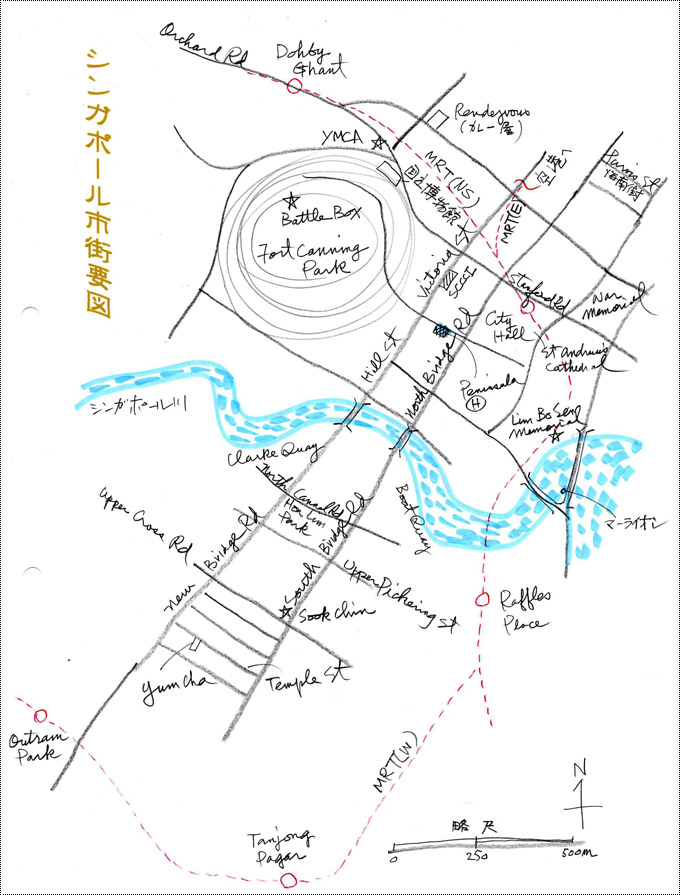
Thursday morning, February 12 Mr. Yew Jing Quan
Ms. Kwa Peng Yong (*) showed up at 09:30am at Peninsula Hotel lobby in the 6th floor. She was to accompany us to Mr. Yew Jing Quan’s. Learned briefly about him at the lobby, as there was enough time left to meet him at 11:00am. Kwa-san translated her writing about him on a Chinese book that lists Chinese victims killed by Imperial Japanese Army during its occupation of Malaya including Singapore. Following is its abstract;
Born in Guangdong in 1914, I moved by myself to Singapore where the eldest brother was in perhaps 1938. Lived in a boardinghouse in Bukit Batok with the brother and some colleagues.
At around 10:00pm on February 14, 1942, I was seized as one of 10 young Chinese guys by IJA soldiers and confined in a farmer’s house
Two days later, IJA brought us to a quarry under a bamboo fence. They killed 7 guys (I was one of them) by around 04:00pm. Other 3 were brought to somewhere else, but their whereabouts is unknown at all; most probably killed as well. I remember the names of the 7 guys including my brother.
When my turn came and being cut by a sword near the railway, I lost consciousness. Two days later, I recovered consciousness. I saw 2-3 Japanese soldiers around. “Run away” “Go home” they shouted at me.
Running hurriedly into a nearby house, somebody there kindly dubbed medicine on my scar on the neck. Later, went to a clinic where a doctor closed the wound with 10 stitches; I could get well after 10 days. The doctor warned me not to tell his treatment to others.
I was a carpenter earning 0.8-1 Yuan a day, have retired 6 years ago. In the last years, I made 2000 Yuan a month. Am living with my wife, have 5 daughters and a son.
IJA was barbaric and horrendous. Don’t understand why I was to be killed. Want Japanese government to make apology and compensation.
By changing metro trains called MRT (Mass Rapid Transit), which surface afterwards, alighted at Bukit Batok Station. Arrived at Mr. and Mrs. Yew’s 100sq m flat on a 5th floor, after 10 minutes walk through apartment houses. Travelling by a coach would be better in 2010. Mr. Yew welcomed us, changing to trousers from a pair of long drawers.
Main points of our conversation, to which Mrs. Yew also joined, with Ms. Kwa’s interpretation follow;
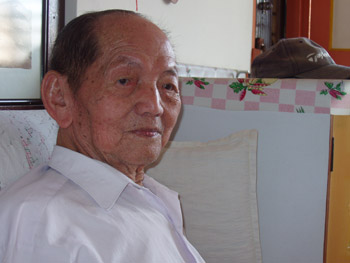
Mr. Yew Jing Quan meets us at his home.
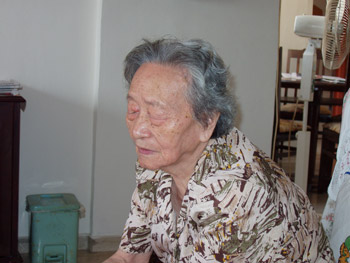
Mrs. Yew
ONOGI: We are planning to visit Singapore with bicycles in February 2010.
Mrs. Yew: You are welcome to visit us then, as far as we are healthy then, which is unforeseeable due to our ages. With the same reason we won’t be able to talk to you much.
ONOGI: It would be very kind of you if we could meet you next year. Our team of around 20 to 30 will visit several cenotaphs in Singapore. We want to visit you as one important itinerary.
Mrs. Yew: That is quite OK. Communicate with our daughter beforehand.
ONOGI: Is your scar still painful nowadays?
Mrs. Yew: No, it is not, except in rainy climate.
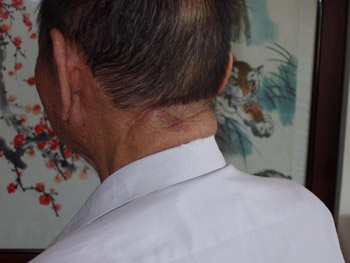
Mr. Yew has a big scar on his neck.
ONOGI: Have you had a doctor to take medical care of the the scar, after stitching it?
Mrs. Yew: Yes, several times with herb in early times, and later with Western medicine. The doctor who treated him requested us not to tell about this to others. He was scared of any lethal rebounds he might face from IJA soldiers.
ONOGI: Did the incident take place somewhere near here?
Mrs. Yew: Yes, it did.
ONOGI: Why do you think IJA tried to kill you folks then?
Mr. Yew: I don’t know at all. I have no idea why I was targeted, being just a carpenter.
TAKI: How many children and grandchildren do you have?
Mr. and Mrs. Yew: We have a son, 7 daughters, and 15 grand children.
Saying good bye to Mr. and Mrs. Yew, took MRT again and alighted at Outram Park Station (*), walked for about 5 minutes lead by Ms. Kwa, and ate ramen and fried vegetables in a retro-style restaurant along a nostalgic street in western end of the China Town.
* Ms. Kwa Pen Yong: A freelance journalist, knowledgeable about Singapore under Japanese occupation. Has visited Japan many times as an interpreter when Yokohama-Asia Forum (www.geocities.jp/afyokohama128/)is held, etc. MPPC has been asking her assistance whenever visited Singapore.
** Outram Park Station: Outram Prison was located just west of the station. Currently, tall apartment houses being built, nothing commemorating the prison is seen around. Local pronunciation of “Outram” is [ootram], unlike popular writing in Japan as [ohtoramu].
Thursday afternoon, February 12 East coast, etc.
After the lunch, went to Changi Airport by MRT, and rented a car at AVIS at the arrival hall.
First, went to the Chinese victims’ plaque in Changi Beach via a familiar route, as we have cycled here in 5MPPC. The issues are, however, from where to start riding bicycles, and how an accompanying coach and a lorry should follow. Next is to confirm the route to the Changi Prison Museum. By driving the east coast roads anti-clockwise, could easily find it, after minor confusion. The route is suitable for cycling.
Another Chinese victims’ plaque in Punggol in a northeast seashore. It took only 20 minutes, after turning right from the Japanese school and taking a toll road. But how to go there with bicycles is a question. Passing under an elevated LRT (Light Rail Train) in a periphery of apartment houses, and forwarding to the sea, the plaque is set in a seashore of the Johor Strait.
Further driving anti-clockwise, headed to Kranji Beach where Imperial Guard Division (lead by Lieutenant General NISHIMURA Takuma) landed, as well as Sarimbun Beach where the 5th Division landed (lead by Lieutenant General MATSUI Takuro). Confirmed the branch road leading to Commonwealth War Graves, Kranji, where 8MPPC should visit in 2010.
The road around Kranji Beach is rather narrow for cyclists, while traffic is few. The monument is in a park near a bridge crossing a big Kranji Reservoir mouth. Hurried to Sarimbun Beach, as the sun was starting to decline. However, the place we entered was the military exercise field, where no such monument was found. A 40cm long lizard laughed at us being flurried, when crossing a gravel lane in front of us. Finally found the place by further going forward the road that we U-turned earlier.
On our way back to the hotel, ran a very wide and straight Lim Chu Kang road, having 4 lanes in each side. It is said that this can be used as an emergency runway where even jumbo airplanes can land and takeoff by folding street lights outward. Returned to the hotel at 08:00pm, and took Vietnamese dishes at a restaurant near Raffles City.
Friday morning, February 13 Meeting with Col. Morrice, et al.
Went on foot for 2 minutes to a magnificent building of Chinese Chamber of Commerce and Industry. Asked a receptionist to meet Ms. Nancy Chew. New staff-like Nancy showed up following Ms. Tan Siew Kiang, a director.

Front of SCCCI building.
In a conference room, following 4 gentlemen already waited for us;
Col (ret) John Morrice (President)
Maj (ret) Roland V. Simon (Navy)
Maj (ret) Goh Say Fong (Public Affairs)
Mathew Lew (Photographer, shot many pictures)
Col Morrice introduced himself as a president of SAFVL (Singapore Armed Forces Veterans’ League). There is a similar organization in Asia Pacific region, and another under ASEAN. There is also a worldwide league to which 119 organizations from 82 countries join, where Col Morrice plays important rolls. The Japanese organization is also affiliated (it must be of SDF). “Are you from one of these?” the Tamil colonel talks and talks without allowing us to open the mouth. He gave us each a cup, shield, and annual report, as souvenirs.
By jumping in him, and assisted by Ms. Tan, we were allowed to say a few words of greeting. We want you SAFVL to introduce somebody who could witness the atrocities of IJA during WWII, said we and handed some copies of memorial pamphlets for 4, 5 and 7MPPC that cover our past visits to Singapore. You should ask SCCCI for such a request, was his reply. Actually, we first asked SCCCI and were introduced to you, said we. Ms. Tan smiled embarrassedly. They would try to find out somebody for us, was the conclusion.
The colonel seemed like he was unable to wait for something, with a PC in front of him and keep standing while all others sitting. He was to present something. As each of us self-introduced, and Maj Simon (His father knew Mr. SHINOZAKI Mamoru (*), and was given a certificate of “good citizen”) and Maj Goh (His father having donated fund to Chiang Kai-shek regime and its medals concealed in the ceiling, they were discovered by IJA. He was arrested and killed in Changi Beach. Maj Goh emphasized that he can forgive the past incident but cannot forget the fact.) spoke briefly, words began to pour from the lips of the colonel.
His presentation with Power Point slides was about how poorly Britain fought the defense battle in Malay Peninsula in WWII. Although there were some misunderstanding concerning IJA’s movements (like “on December 8, 1941 the Imperial Guard Division landed on Kota Bahru, and 18th Division on Singola”**), his main point was how inefficient the British military was against Japan. He touched on Kranji Beach and Sarimbun Beach where we went previous day, as well as very details of the defense line deployments including specifications of cannons set in Kent Ridge Park and Labrador Battery where we plan to visit in the afternoon, for 2 full hours. To our jump-in question of whether there is a similar monument showing the landing point of 18th Division in Singapore, he answered no, because it is in the military exercise field. This must have been a very precise information than could have gained otherwise at somewhere like the Tourist Bureau.
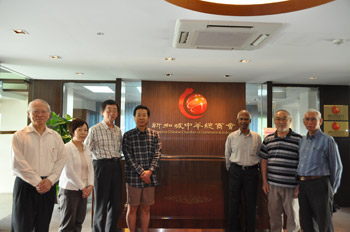
Col Morrice (central right), Maj Simon (right), and Maj Goh (left)
* Mr. SHINOZAKI Mamoru was a staff of Japanese Consulate in Singapore. He was arrested by the UK government in allegation of spying in 1940, detained in Changi Prison, and was released by IJA on February 16, 1942. He was thanked by Singaporeans by issuing certificates of “good citizens” during Japanese occupation. His English account “Shonan-My Story” was later transcribed into Japanese with a title of “Untold Stories of Singapore Occupation.”
** The 25th Army lead by Lieutenant General YAMASHITA Tomoyuki landed on southern Thailand and Kota Bahru, northern town of then Malaya on December 8, 1941. The troop that landed on Kota Bahru was Takumi Detachment (18 Division) lead by Major General TAKUMI Hiroshi, which was the earliest attack of Japan at 02:15am (Tokyo time), or earlier than the navy that attacked Pearl Harbor by one hour. Being informed of this success, the 5th Division started to land on Singola (Songkhla today) and Pattani, southern towns of Thailand. The Imperial Guard Division under 14th Army crossed the border from Cambodia into Thailand by trucks on December 8, and occupied Don Muang Airport. After serving as security force in Bangkok for 2 weeks, was transferred to 25th Army. It joined the Malaya campaign on December 25 at Alor Setar. On the other hand, the main force of the 18th Division was in Guangdong on December 8. It landed at Singola on December 22, caught up the 25th Army at Johor in late January, and joined the operation from then on.
Friday afternoon, February 13 West coast, etc.
Finishing quick lunch, went to the monument of Jurong-Kranji Defense Line, which was to provide against IJA invasion from north-west. It was in a small Neighborhood Park among apartment houses of Jurong West Newtown. Being surrounded by a temporary fence for construction, it took some time for us to locate it. Whether or not to visit here by bicycles needs to be decided.
Next destination is another monument in Kent Ridge Park where fierce battle of Pasir Panjang was fought. It was on a hilltop, climbing a steep road branching off from Bouna Vista road after Pasir Panjang road.
Labrador Battery was on another hilltop, from Pasir Panjang road and turning at the crisscross of Alexandra Hospital. This was the tunnel commanding fort of the British front. A replica of large cannon that the veterans explained this morning was displayed. Entrance fare to the tunnel was SD8.00. A Chinese curator explained the insides. There were lifts to supply bombs to surface cannons, but all in all the area was smaller than that of the Battle Box.
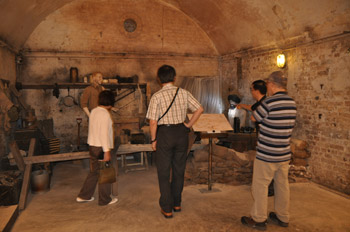
Listening to the curator’s explanation in Labrador Battery.
Then went to Sentosa island, and visited a Sentosa Office, which was assumedly an admin office of the island. We want to see a plaque for Chinese victims massacred here which is said to be located in a golf course, was our request. A Malay woman receptionist kindly answered by saying “I will call my husband nearby. He used to be a manager of the island.” Mr. Masturi Lehwan appeared soon. According to what he wrote for us later, he used to be involved in development of the island.
Mr. Masturi said that once there was a cenotaph in the outer shore of the island, but no more. Instead, there is a small one on the main island side. We badly want to see that, we asked. You can, but only one person because you should go there by a two-seater buggy (cart), a driver and one more, he said. KURACHI was selected as he had a video camera, and went on a buggy with the former manager’s drive. After a few minute drive, arrived at a 80cm high plaque, which is seldom introduced in Japan. It resembled to the one in Changi Beach.
The epitaph was written in 4 languages, Japanese, English, Chinese and Tamil, which read “From February 20, 1942 for 8 days, hundreds of Chinese people were tied on their backs with 4 in each bundle, and brought from Tanjong Pagar Dock by boats to the off shore. IJA soldiers pushed them in the sea, and cross fired. Many corpses were washed up on the shore of Blakang Mati (present Sentosa), which British prisoners of war buried around the battery. The victims were part of tens of thousands Chinese Singaporeans who were deemed as anti-Japanese, and killed by IJA in the notorious Sook Chin process.” (translated from Japanese)
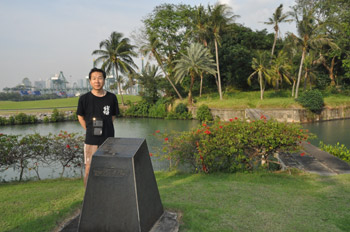
Plaque commemorating the Chinese victims massacred in a golf course of Sentosa island.
The golf course is open until 07:00pm every day, except 2 maintenance days a week, the manager said. If MPPC wants to see the plaque, you are encouraged to see on one of these closed days. “They are Mondays and Tuesdays in 2009, but unknown for 2010.” We should check that right before the trip.
The site being in midst of a golf course, it is improper to approach with a large coach even on a maintenance day, nor with a motorcade of 20-30 carts (buggies), which would be costly too. It would be best to go by bicycles, including rented ones available in the island, allowing only those who cannot pedal bicycle to ride the buggies, with a guide of somebody like Mr. Masturi. We should see Images of Singapore and Fort Siloso in the island as well.
Saturday, February 14 To JB via central part of Singapore, and Tuas on the way back.
At 08:00am, went to MacRitchie Reservoir by the rental car confirming the route; the tomb of Mr. Lim Bo Seng (*) is in this park.
And then a monument in Bukit Tima (**), and a memorial museum of the Old Ford Factory (***). Newly erected as a neat museum, Old Ford Factory has an audio room for VTR introduction to visitors, and well organized displays. We stayed for only one hour, having another schedule of visiting Johor Bahru; but 8MPPC should stay here much longer.
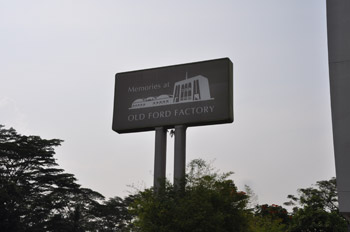
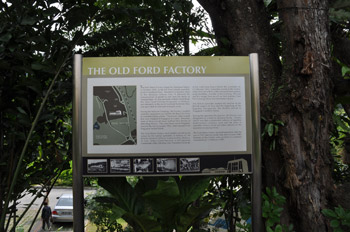
Sign board of Old Ford Factory.
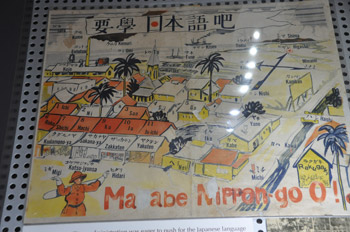
Displays in the Old Ford Factory museum.
Immigration clearing process was lengthy and boring both at Singapore and in Malaysia. At 8MPPC, we must be well prepared for the border crossing, including to provide Malaysian E&D cards beforehand.
Roads in JB were much different from what we knew before. Our favorite Eden Garden Hotel has changed to Zon Regency Hotel. ONOGI and KURACHI went into the hotel to check conference rooms, etc. Took lunch outside, whose owner must have changed as well. Need to find nicer alternative for dinner, as we will take dinner twice in JB.
Confirmed the Chinese victims cenotaph of Johor next to a middle school along Jalan Kebun Teh, and then the Japanese cemetery nearby. After some confusion in taking Route #1 toward KL, but instead returning to central JB in opposite direction, finally came across the intersection of Route #5 leading to Ulchoh and Gelang Patah.
Could locate 2 cenotaphs in Ulchoh easily, but had to toil finding another one in Gelang Patah. It was because the roads had been completely renewed, and the cemetery was surrounded by tall hedges.
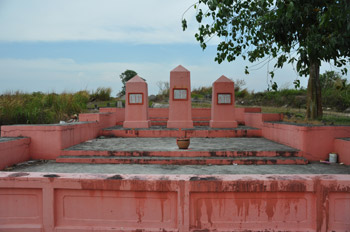
One of 2 cenotaphs in Ulchoh, Johor.
Could not find the last one around here, gave up, and headed back toward the hotel, Singapore.
Intended to take the new second bridge rather than the Causeway Bridge again, but avoided to return as far as to the IC in Gelang Patah. Could find an IC near the Johor Strait as speculated, but the sign was far from our knowledge; it said Tuas in Malay for one direction and KL, Singapore for another. We selected safer latter option, but found after driving the toll way that this was leading inland; “Singapore” must be via Causeway Bridge through JB. Without hesitation got off at Gelang Patah IC, U-turned and took the way toward “Tuas,” which was right; another bitter trial of the preparation. The bird’s eye view of Johor Strait from the second bridge was splendid, exactly what we expected.
Could return the car at Havelock Road shop within allowance time and without additional fee. Hurried back to the hotel by a taxi, and could go with Ying Lei (**) and her husband to Purvis Street on foot as promised. It was one bloc further from the Vietnamese restaurant. Hainan foods were excellent with plenty of local customers, recommendable for 8MPPC.
Becoming full, saying good bye to Ying Lei couple, returning to the hotel, KURACHI and SHISHIKURA collected their baggage and departed to their home country.
* Mr. Lim Bo Seng (1909-1944) belonged to anti-Japanese Force 136 under South East Allied Command, and was assigned as a colonel by the Kuomintang regime. He was arrested by IJA in outskirt of Ipoh, and died in Batu Gajah Prison. After the war, his corpse was brought back to Singapore, and reburied with a public funeral conducted by British government and Chinese groups.
** The monument of Bukit Tima: One of monuments that Singapore Government erected in 1995 commemorating the 50th anniversary of WWII (together with those in Kranji Beach and Sarimbun Beach, etc.). Another heavy battle took place here.
*** The Old Ford Factory museum is the place where Lieutenant General Percival surrendered with a white flag to Lieutenant General YAMASHITA Tomoyuki on February 15, 1942. The museum opened just few years ago.
**** Ms. Ying Lei is a reporter of Lianhe Wambao, is from Nanking. We knew her since 2005 when she first covered our participation in the February 15 ceremony. In 2007 she married to Zheng Yu Dong, City Bank, who is from Shanghai.
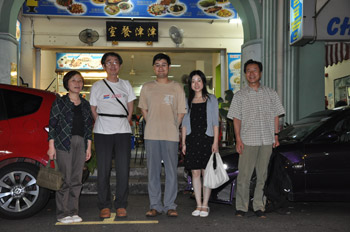
Yu Dong (center) and Ying Lei (his right)
Sunday morning, February 15 Ceremony at the War Memorial
Crossing the St. Andrew’s garden on foot diagonally, remaining TAKI and ONOGI went to the War Memorial Park at about 15 minutes before the ceremony time of 09:00am. Found Nancy Chew under a large tent, 20% of the seats being occupied so far, and asked where our seats were. They were in the third row from the front, with a sign of MPPC on the backrest. Two rows ahead of us were for religious delegates, and on our right were for Col Morrice and Maj Goh, SAFVL.
The ritual was just as usual and smooth, after the main guest Dr. Lee Boon Yang, Minister of Information, Communications, & the Arts arrived 15 minutes later than scheduled.
Before and after the ceremony, Col Morrice introduced us to other SAFVL gentlemen, and admin like person of the religious delegates. Shook hands for the first time with Mr. Soon Peng Yam, the president of SCCCI. Were introduced to the minister as well. After diplomatic exchange of some words and photos (taken by somebody, not us), he continued to talked to us, which was more than welcome.
“We feel very sorry” said Onogi “that the Japanese Government is yet to formally make apology for the massacre of Chinese victims. We believe that Japan would not be dully accepted in the world unless it makes sincere apology and pay necessary compensation.”
“Agree.” said the minister. “However, be sure that Singapore Government is not requesting anything to the Japanese Government. But I know that ordinary citizens may have different feelings toward Japan.”
Onogi responded by saying “We think that the apology and the compensation should be initiated by the Japanese Government itself, as well as by Japanese society as a whole. Unfortunately by some reason, the general public has different perspective so far, while we are minority in this field. That is why we came here within a capacity as Japanese citizens to participate in the ceremony”
“If you look at Germany,” the minister returned “the president has formally made apology for the Nazis’ holocaust and been paying large amount of compensation. The difference between two countries is obvious.”
The minister was frank and vocal. Incidentally, his thought overlaps with what Mr. David Lim, then acting minister, said to us at the same ceremony of 2003 when 5MPPC joined it (see the English caption on p-64, the memorial pamphlet of 5MPPC). This undoubtedly implies that although diplomatic and economical bilateral relations are lasting, unless Japan sincerely reflects the WWII, there will be no unreserved ties between the two countries. This may apply to other concerned countries equally.
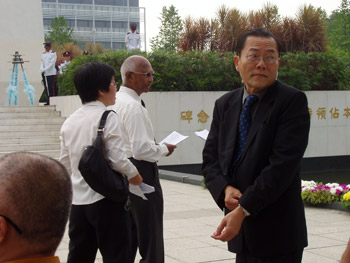
Col Morrice (center) and Ms. Tan (his left) before the ceremony.
MPPC’s wreath, which we have requested Nancy to arrange earlier from Japan, was not found in the usual right nor left side of the Tower, but right under the 4 legs as if guarding the big urn. There was no other wreath nearby, which also meant special treatment of MPPC.
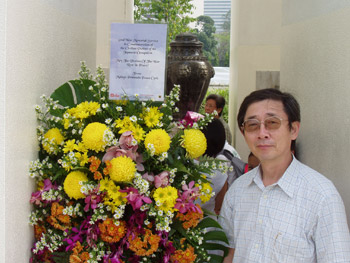
Wreath of MPPC.
Prof. TAKASHIMA Nobuyoshi (*) was around, together with a young Mr. MATSUDA Hiroshi, a graduate student of University of the Ryukyus. They were to go to Perak, Malaysia after the ceremony, and visit the “isolated tomb” (**) of Bidoh in a jungle with a guide of Mr. Low Toh Nam. That was their preparatory trip for “Vicarious Experiences of the War Trip to Malay Peninsula” planned in August 2009. “Memorial Pamphlet of 7MPPC was very informative” said the Professor. Mr. MATSUDA looked an eager researcher, as he asked several detailed questions to us regarding the massacre of Salak Utara, Perak, which we reported on that booklet.
* Prof. TAKASHIMA Nobuyoshi: Professor of Ryukyu University. He has lectured for MPPC in the past. He has been organizing “Vicarious Experiences of the War Trip to Malay Peninsula” in August every year. For details see: www.geocities.jp/afyokohama128/
** Isolated tomb: It is a cenotaph for Chinese victims located in a jungle of Bidoh, Perak, Malaysia. See details in the memorial pamphlet of 7MPPC.
Sunday afternoon, February 15 Historical sites in the City
Changing back at the hotel, checked out, and left bags at the lobby concierge. Headed on foot to the monument of Sook Chin (=massacre. Actually the place is where “insurgent” Chinese people were segregated, but customarily called as is). Following the North Bridge Road which turns as South Bridge Road after Singapore River, found a guide board on a pedestrian road. Coming to the cross with Upper Cross Street, the corner was totally surrounded and under construction, while the monument was nowhere, perhaps tentatively moved to somewhere. Wish it may be rebuilt by February 2010.
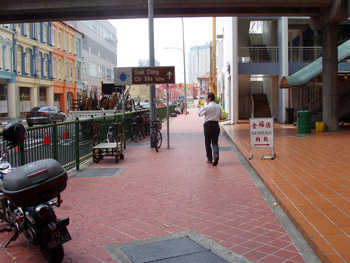
Guide board of “Sook Chin” in the South Bridge Road.
That’s the way it is. Let’s take lunch. Wandering around the town to and fro, went into a Yum Cha Restaurant in midst of shabby shops and stalls along Temple Street (Its Chinese characters literally mean “climbing grandma”). Stepping up a narrow stairway, wide 2nd floor was for ordinary customers where you are supposed to order whatever foods on wagons pushed by waiters/waitresses between tables, while the 3rd floor for reserved customers with quiet mood. The 2nd floor is strongly recommended for 8MPPC to enjoy noisy and chaotic yum cha system. The prices, diversity of foods, as well as the atmosphere were not bad.

A sign board of Yum Cha Restaurant is seen in the Temple Street, China Town.
Returning toward the hotel along the New Bridge Road, which turns into Hill Street after the river, there is a Fort Canning Park on your left hand with steep stone steps of about 70-80. With thick leaves around and the twisting river below, the air was wonderful. Signposts were here and there explaining early histories.

Stone steps to Fort Canning Park from the back side of the hill.
At the Battle Box (*) in the hilltop, asked if there are any significant changes of displays, which was answered no. But 8MPPC should visit here anyway. Climbed another stone steps down to the opposite side. YMCA building is on left hand side to the National Museum. Tudor style building having been renewed, this was used as the East Kempeitai (military police) HQ, where many people including Ms. Elizabeth Choy (**) were falsely arrested and tortured. The monument commemorating that incident is in a side of the current building.

Monument in the side of YMCA building.
It is recommendable that 8MPPC walk around similarly, namely after the 2.15 ceremony, change at the hotel, look around the places mentioned above on foot (or by the coach as appropriate), and finally enjoy yum cha or dim sum, some free time in China Town, collect the baggage and forward to the airport. One additional place that we did not visit this time but 8MPPC should, is a monument of Lim Bo Seng along the Elizabeth Walk near the sea.
* Battle Box: British Command in the tunnel on the top of Fort Canning Park. Among the displays, there is the final meeting scene of commanders in the morning of February 15, 1942 discussing whether or not to surrender to IJA.
* Ms. Elizabeth Choy (1910-2006): She was falsely arrested on October 10 together with many Allied civilian internees and Chinese (Double Tenth Incident) in allegation of sinking nearly 40,000 tons of ships harboring in Singapore Port in September 1943. She survived almost killing torture of the Japanese military police. The fact disclosed after the war was; the blasting was the successful outcome of the Jaywic Operation, whereby British and Australian special warriors sailed from Perth, Australia with a small boat. Luckily, 4MPPC could meet and talk with Ms. Elizabeth Choy at SCCCI.